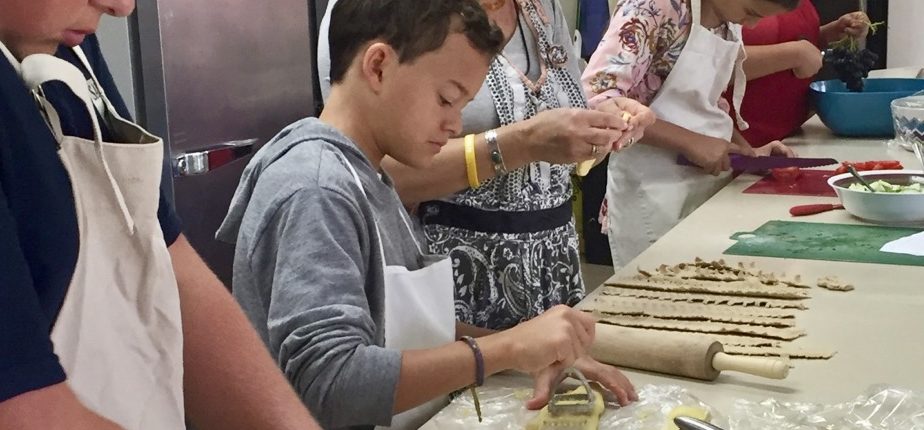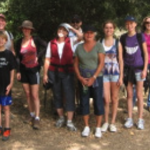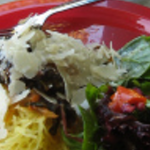
One Friday in late September of 2011, after an afternoon with some students at the park, I provided a ride home for two of them. While driving, something miraculous happened. One of the students told me he had gone to Burger King recently and, to his surprise, he wasn’t as interested in the burger as he once was. In fact, he said, it kind of made him a little sick. Now, I don’t mean to pick on Burger King, but there is a good reason why this was a miraculous statement. You see, One Spark Academy had just opened its doors at the start of the month, and we implemented our “Healthy Lunch” program right away. This student had been nervous about that one aspect of our program. He was not a fan of healthy food or tasting much of anything new and different. Yet, over the past four weeks of healthy lunches at One Spark, he had increasingly expanded his taste buds and challenged himself to try new foods. So, when I asked him why he didn’t enjoy the burger as much, he declared that it was due to how good all that healthy food made him feel. I tell ya, that was a moment for celebration. If I hadn’t been driving, I’d have jumped for joy.
The commitment to healthy food at One Spark didn’t just happen overnight. I had tried and tried to implement such a program for years. Let me back up and tell you why.
I grew up in a family where homecooked food was a primary focus of our time together. I can’t say it was entirely healthy, but there was always an abundance of natural, wholesome ingredients. Still, the struggle to maintain healthy habits was there (a combination of culture and genetics), and my father ended up struggling and, ultimately, losing his life to diet-related illnesses in 2013. Around the same time as my father’s health was declining, I was seeing concerning trends of food addiction, misinformation, processed-food diets, body image struggles, and an increase in medications (for kids) overlap in my students. I knew that so many of these issues could be helped if students had a healthier relationship with food, which involves information and participation.
Just to clarify things a bit, I’m not a dietitian or even someone who claims to know a lot about food science. I could certainly eat healthier food more often, and less food altogether. However, what I can do is recognize what food is and what food is not. I don’t kid myself when eating non-nutritive food, by thinking that because it says “High in Calcium” that I shouldn’t be eating my spinach and yogurt (although some varieties of yogurt have as much refined sugar as a can of Coke). Additionally, like many healthy adults, I recognize that the more our factories have taken whole ingredients out of foods and replaced them with chemicals, preservatives, and processing in order to make them “less caloric and more nutritious”, and then combined this with unrealistic portion sizes, the fatter and more unhealthy as a society we have become. As consumers and shoppers, we can make informed choices.
Unfortunately, most children can’t make these choices because they just don’t know what real food is and what it is not, and they are not doing the shopping. They don’t know where their food comes from either. As one case in point, you may have seen the video of British chef Jamie Oliver interviewing a classroom of children, and the students couldn’t recognize a tomato from a zucchini. (If you have not seen it, view it here.) Furthermore, there is very little ability to determine how many treats are too much, when processed foods and treats can be a 3-meal a day occurrence. During one school week in the 2009-2010 school year, while still in the public school system, I had four afternoons where well-meaning parents brought in unexpected birthday treats (after all, birthdays only come once a year, right?), and on that Friday we had a rewarded ice cream party (a school decision, not mine). Thankfully, because of the lessons my students had had about food, a few of them recognized that what was being served was not really ice cream, but a totally processed alternative, and they passed (!). Generally speaking though, when this overall lack of knowledge is combined with an addiction to sugar, salt, and certain chemicals, we’re in big trouble.
During the final seven years of my teaching in the local public school district (CVUSD), I experimented with “Healthy Lunch” in my own classroom, and the results of this “experiment” were fundamental to my educational philosophy at One Spark Academy. Here are a few conclusions I made.
Firstly, the more people there are who eat healthy food, the more fun it is. When it’s “cool at school” to eat well, more students will bring in real food to snack on and enjoy for lunch. They’ll talk about their foods, they’ll outdo each other in how many veggies they’ll pack into a salad, and they’ll share a delicious homemade concoction. On the other hand, when there is an absence of community support regarding healthy eating, as there is in most schools, even the best of intentions get sabotaged. While in the public education system, I often found wholesome sandwiches, whole fruits, and entire salads thrown into the trash outside my door, or lunchboxes left for days with homemade tuna salad in them. On one occasion, I found two Hershey bar wrappers right next to a beautiful untouched sandwich, in the trash. Why? Probably because a peer had a roll-up, cookies, or chips, or that child simply needed to rush off to play. The second conclusion is that most kids have no idea what healthy food is, and this requires real instruction and a commitment to change. For example, students used to tell me that a granola bar should be one of their three wholesome, “real food” items at our Healthy Lunch because “This is from Whole Foods” (which is a great place where I love to shop, no doubt, but even Whole Foods sells some processed food. How about some locally grown fruits from Whole Foods?). Or perhaps, “It’s healthy because it’s a salad.” Well, when that salad consists of iceberg lettuce, croutons, and two heaps of fat-filled dressing, it’s not better than a donut. Helping children understand this required actual lessons, combined with options for better choices. Thirdly, teachers and parents are roles models and need to lead the way. When we started One Spark Academy, we had the buy-in to make this happen. That is why our One Spark staff doesn’t bring fast food, soda or junk food onto the premises either, and we ask that all adults visiting do the same.
Few can argue that by creating a culture and environment that supports good health, we have a chance to change the patterns and habits that children are developing. Unfortunately, we must first look at some uncomfortable statistics to understand the urgency of the healthy food movement in schools that is gaining momentum. For one, it is believed that 1 in 3 children will develop diabetes either as children or adults. Type 2 diabetes is most often caused by a lack of physical activity and poor diet, which includes the over-consumption of sugar and of foods that raise sugar levels in the body. In fact, according to the World Health Organization (WHO), it is expected that 366 million people will have diabetes by 2030, just about double today’s figures. Once diabetes kicks in, it is noted that fewer than 5% of type 2 diabetics can make the lifestyle changes required for treatment. After all, sugar is an addictive substance. The best way to control type 2 diabetes is to prevent it in the first place, and the number one way to prevent it is to change one’s environment. The saying “Out of sight, out of mind” is helpful to remember. For this reason, I’ve asked that certain foods not show up at One Spark Academy.
Other challenges we have as a society include the increased portion sizes that children are getting used to, the prevalence of fast food, and the empty calories in many processed foods which children regularly eat, combined with a reduction in physical activity in lieu of students’ personal devices or videogames. All of these societal structures contribute to rising obesity rates in children, which is a more serious threat to lifelong wellness than gaining weight as an adult. Most children who are obese spend their lives being obese since habits developed in childhood are hard to break. (Some good news is that there has finally been a slight decrease, or leveling off, in some states. See this link for more.) And, obesity in children contributes to low self-esteem and shame, which only perpetuates the cycle of over-eating. I’m sure there are many more facts and figures that we can all drum up, but the point is clear: education about health and nutrition has to happen at home AND in the learning environment since the environment amongst peers is a huge factor in determining what children think and how they behave.
At One Spark Academy, we take this commitment very seriously; it is our intent to try and “walk the walk” when it comes to nutrition. After all, how can we espouse whole child education without looking at the foods we promote in our daily lives? How can we expect children to develop healthy habits, or understand the importance of moderation in snacks and treats if there is no peer group with whom to practice? It’s important to note that, even in our own efforts, we can’t make everyone happy. Some tell us they wish we served even healthier food. Some tell us that serving ingredients like quinoa and kale are too much for their kids with limited tolerance for healthy ingredients. Some may object to our infrequent use of animal products. Sometimes we make allowances for extra treats. However, our mission is clear: to teach students about nutrition, use as many wholesome seasonal ingredients as our budget will allow, and make time for students to enjoy a balanced (and tech-free) meal with peers.
If you have had the opportunity to experience any of our One Spark lunches, you know they are special! Students not only get involved in the prep and set up of lunch two days a week (yes, they chop vegetables, peel onions, squeeze lemons, and much more), but we ALL sit down together and enjoy menu items that Laura, Sue, and Jenni have organized. You might find sautéed vegetables over whole grains, quinoa salad, butternut squash tacos, tofu stir fry, Chinese chicken salad, fresh guacamole, freshly made sweet potato chips, chopped fruit kabobs, fresh smoothies… the amazing list goes on. You also might find pizza, or omelets, or less healthy items on occasion. Since we know that not all students come to One Spark ready for quinoa and kale, we do often have simple (processed) foods, like pasta or rice, to ensure our students have eaten enough while sampling some new ingredients. Oh, and our desserts? Delectable. Homemade pies, ice cream, cookies and more, served on many occasions and in moderation. As a bonus, all of our food is served on reusable plates, with silverware and real napkins, and all of the scraps are composted.
Therefore, my case for Healthy Lunch is really a request that everyone try something different when it comes to “school lunches”. Please join me in helping make One Spark Academy a place where kids love to eat well, where we all enjoy and understand the benefits of real food, and where we all commit to being a little healthier every day. If we ALL have a shared vision, our philosophy at One Spark will succeed in its promise of promoting better health. The best part is that, by embracing this mindset outside of the instructional day, your whole family will reap benefits that will last a lifetime – perhaps a much longer one!
~ Lori Peters, July 2022 (updated from an original publication in November 2011)


